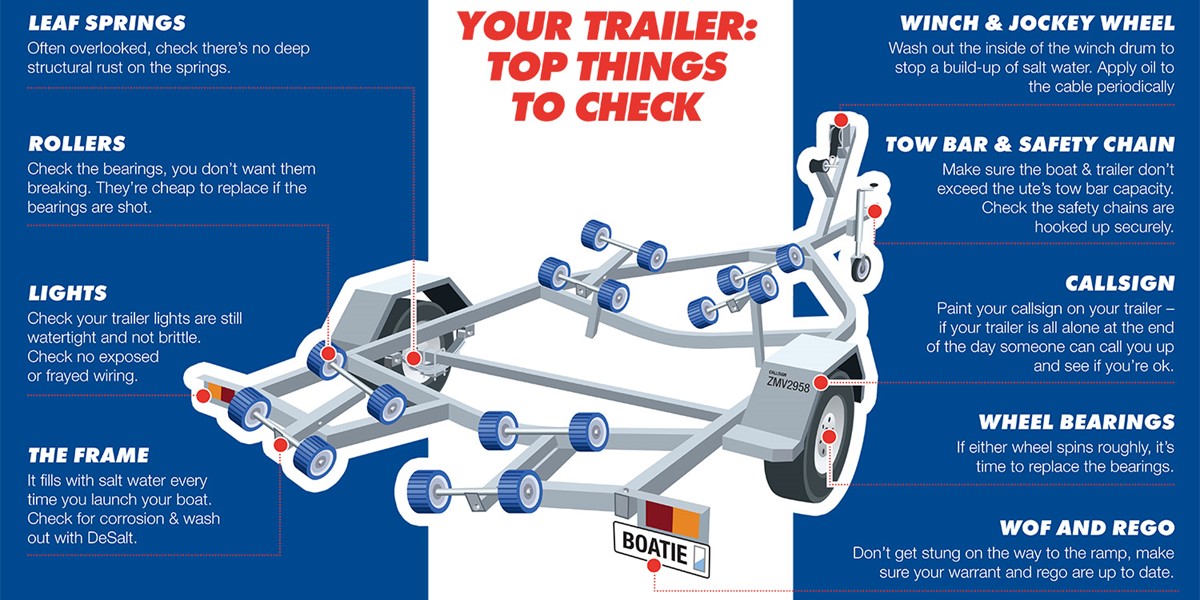A trailer might seem pretty simple compared to your boat, but there’s still a lot that can go wrong if you let it.

At worst, you could end up with your boat on the side of the road, not the way to start a day out on the water!
As with your boat, the first and simplest task is to wash your trailer and tow vehicle regularly. As trailers regularly get reversed into corrosive salt water, make sure to rinse yours thoroughly with fresh water once you’re done for the day, to remove residue.
The frame
As soon as you are able, use a gentle sponge or cloth and carwash soap for best protection. Most trailers are made of box section steel, a lot of which fills with water each time you launch, via vent holes required for galvanising or wiring. A good wash inside and outside the frame and of the components (paying special care to the get the springs, hubs and brakes if fitted) every time you return from the boat ramp is key.
We recommend a DeSalt solution, which effectively clears away the salty deposits, helping your trailer stay reasonably rust-free.
Rollers
As the main point of contact between your boat and your trailer, make sure you keep the rollers lubricated and check them periodically for cracks or damage. They’re simple to replace if you need, and worth the small expense to do so.

Winch, jockey wheel
Keep the winch drum well-greased, with all the moving parts of the winch oiled up – the cable brings a lot of sea water into the drum, which can rot it from the inside out. A visual check of the cable for any fraying is a good idea, while a little more grease on the shaft and bearings of the jockey wheel will keep that in tip-top condition. Don’t forget to check the safety chain too.
Lights
Even quality units can end up with corrosion on the electrical points, if a small leak has developed. Unscrew the covers and check for blown bulbs and corrosion; when you’re putting them back together, add a little silicone or Vaseline to the seal to ensure water tightness. If they’re looking a bit too rough, consider replacing the units.
Most trailers are now being fitted with submersible LED lights which are more rugged and reliable.
Leaf springs
Surface rust is common, but deep rust is a bad sign. Replace if necessary.
Wheel bearings
One for the mechanics, we reckon – it’s easy to stuff up. But if you’ve got the time and patience, remove the bearing cones and re-grease them. If they’re shot, take them down to your local auto store to replace them.
Watch your weight
When you’re loading in extra fuel, ice and camping equipment (don’t forget the bait) make sure it’s evenly distributed – a good rule of thumb is 60% of the weight towards the front, 40% to the rear. Here’s a great video to demonstrate what happens if you don’t distribute the weight well.
Use a safety chain
Use a safety chain between the towing vehicle and boat trailer, with double chains required if the tow weight is more than 2,000kgs and there’s no additional braking system fitted.
Check the tow bar
Make sure there’s no corrosion or cracking in the welds or structure. Is the tow ball secured properly to the tongue? Towballs also have a maximum vertical loading – make sure that you don’t exceed this.
Check your trailer tyre pressure
Most are 8-ply truck tyres so pressure should be around 60psi (you’ll find the correct pressure stamped on the tyre or the VIN plate).
Watch your angles
You’ve got extra length so when you corner, a boat trailer will take a tighter arc than the vehicle, meaning it’s all too easy to mount the kerb or drop a wheel into a ditch. Take the corner wider, and watch your angles!
Prop cover
An outboard motor sticks out quite a bit. When you’re stopped at a light, others may misjudge where your motor actually is. A high-vis prop cover (with an attached red light) makes sure your motor is seen, night or day. A good quality prop cover will also help protect your prop from nicks and minor damage, which can affect its performance on the water.
Boatie's Best Mate.
Get a Coastguard membership today for peace of mind when you’re out boating.

